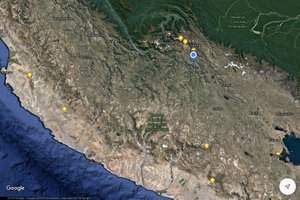Advertisement
Published: March 31st 2019

 Southern Peru
Southern Peru
This may give you an idea of the area we covered in the past 10 days.Our final 5 days in Peru were spent in the heart of the formerly glorious Inca Nation. At its height, when the Spanish arrived in 1523, it stretched from Chile and Argentina to Colombia. It is mind boggling that fewer than 200 Conquistadors destroyed a powerful empire of 15 million!
We marvelled at their building skills, without iron, the wheel or animals that could do the hard work, in really demanding terrain.
Their scientists developed strains of potato, corn and grains suited to climates from rain forest to desert. Yet they had no written language to record their accomplishments. The Spanish managed to reduce their number to less than one million through disease, wars and the Inquisition.
The Inca was the king. The common people were “of the Inca” his to command.
Panoramas (5 seconds between each)
1. Plaza de Armas, Cusco.
2. Maras salt ponds
3. Above Cusco
4 & 5 Machu Picchu
Enough of that lecture. Hope you enjoy the photos.
Advertisement
Tot: 0.353s; Tpl: 0.012s; cc: 7; qc: 46; dbt: 0.0753s; 1; m:domysql w:travelblog (10.17.0.13); sld: 1;
; mem: 1.1mb

 Southern Peru
Southern Peru







































Garry Rasmussen
non-member comment
Grande Finale
After all this adventure and exercise I think you two need to find a nice cosy place by a beach where you can veg out for a while and design photo books! :)